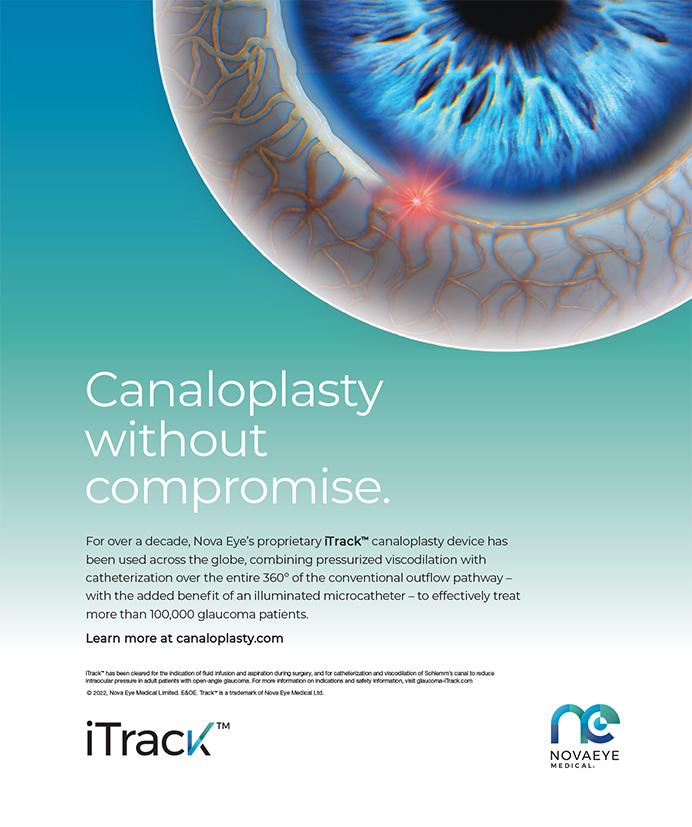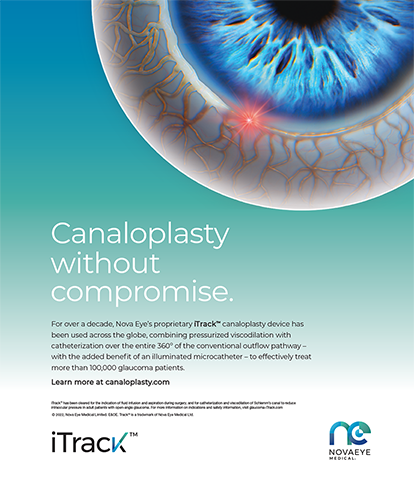I am an American citizen, but I went to high school and medical school (Cambridge University) in England. After 3 years of bioengineering research at the Weill Medical College of Cornell University, I did my residency training in New York (Mount Sinai) and corneal and refractive fellowship in Vancouver (University of British Columbia). I am board certified in the United States and Canada, and thanks to the FDA, I am now board certified in the United Kingdom. I think of myself as a technological migrant—an American academic refractive surgeon with technological refuge in the United Kingdom.
opportunities TO WORK WITH INDUSTRY
After a successful run as medical director of a corporate LASIK chain where my role was to develop standardized protocols, training, and quality control for optimizing the safety and accuracy of LASIK,1 I was approached in 2001 by Carl Zeiss Meditec to be its medical consultant during the development and launch of the new MEL80 excimer laser. At that time, first-generation (nonaspheric base) myopic wavefront-guided treatments were just starting in the United States, but hyperopic and mixed-cylinder wavefront-guided as well as topography-guided therapeutic treatment modalities were already available in Europe. This consulting opportunity opened up the chance for me to work at the cutting edge of excimer laser development with the added advantage of living and working outside the jurisdiction of the FDA.
I founded the London Vision Clinic in 2002 and have never looked back (except when I return for the American Society of Cataract & Refractive Surgeons and American Academy of Ophthalmology meetings). Since 2001, I have been involved with the most advanced design of aspheric profiles. I developed a method of using spherical aberration to increase the depth of field now used in Laser Blended Vision (Carl Zeiss Meditec) treatment for presbyopia2 and developed new ablation profiles to control the induction of spherical aberration and extend the range of suitable patients into high myopia. I have been treating presbyopia and very high myopia for 10 years, and none of these treatment options are yet available to surgeons and patients in the United States. In fact, probably as a result of the Internet and the globalization of information, I have a number of American patients who travel to the United Kingdom for treatment.
Although my professional research career began in the United States at the Weill Medical College, Cornell University in New York City, where I led the development of the (FDA-approved) Artemis (ArcScan, Inc.) VHF digital ultrasound scanning technology, had I not moved to Europe, I would have missed the accelerated opportunities to apply and use this technology to its full potential. I have also been heavily involved in the development of therapeutic refractive surgery techniques—the repair of corneal complications and irregular astigmatism in a way that would have been impossible if I had stayed on faculty at Cornell.
I often think of the stark contrast to my dear US colleagues who can still only offer a wavefront-guided retreatment to someone with irregular astigmatism—a treatment that has been known for years now to be significantly less effective than a topography-guided custom ablation.3,4 By leaving the FDA's jurisdiction, I have had opportunities to be deeply involved in Carl Zeiss' topography-guided custom ablation software for the MEL80,3 and we are approaching exciting times in reaching the holy grail of repair technology with stromal surface (subtopography)-guided ablations. The Artemis work revealed the critical importance of understanding the compensatory epithelial thickness remodeling in cases of irregular astigmatism,5 and we are currently working on integrating this information with topographic data to further improve the effectiveness of custom ablations. This is again, something that would be unimaginably complex (and therefore literally prohibitively expensive) to develop with the current FDA assessment and approval methodology. Complication repair is the most common reason for American patients to come to my clinic, as their surgeons in the United States are unable to offer them the best treatment options, and many of these patients are actually referred to us surgeons in Europe by US surgeons for this reason.
THE United states is behinD
It is worth pointing out that this regulatory situation is unique to the United States. Given that the United States is devoid of advanced repair tools, the number of entirely repairable cases in the United States has probably become artificially high. I suspect that is the reason why the FDA has been hammered by patients' complaints. Here's a definition of irony: A former chief scientist in charge of the clinical trials at the FDA who recommended the approval of LASIK is now criticizing LASIK6—the procedure—not the FDA's relative incapacity to keep the American ophthalmologist equipped with the best, safest, and most effective treatments, which are approved worldwide in a timely and cost-effective manner.
In 2007, I was among the first to start using the VisuMax femtosecond laser (Carl Zeiss Meditec),7 which has proved to be a significant advance in corneal femtosecond laser technology with the three-dimensional stromal cutting accuracy required to cut refractive lenticules and with features such as the curved contact glass and corneal suction, which make the patients' experience one of “I felt absolutely nothing.”8 The design of the VisuMax has enabled it to be the first femtosecond laser to be used to perform keratomileusis intrastromally through a keyhole pocket incision, with the introduction of the procedures femtosecond lenticule extraction (FLEx)9 and small incision lenticule extraction (SMILE).10 It is going to be a few years, however, before these treatment options are available to US surgeons and patients.
SUMMARY
In summary, my decision to move to the United Kingdom has meant that I have had access to the best technology at least 2 to 5 and sometimes 10 years or more before it became available in the United States. This has meant that I have been in a position to offer patients the best possible care in the world, while at the same time enhancing my interest, involvement, and enthusiasm for continuing research and development in the field of corneal refractive surgery. It frustrates me to see articles in the peer-reviewed literature of highly effective therapies that remain out of reach of my colleagues based in the United States. With so many innovative, extremely experienced, and talented American refractive surgeons, the remaining question is, how much further would we have come if the same technology and treatment options had been available to everyone?
Dan Z. Reinstein, MD, MA(Cantab), FRCSC, DABO, FRCOphth, FEBO, is founder and medical director of the London Vision Clinic, London. He is a consultant for Carl Zeiss Meditec, has a proprietary interest in the Artemis technology (ArcScan Inc.), and is an author of patents administered by the Cornell Center for Technology Enterprise and Commercialization. Prof. Reinstein may be reached at dzr@londonvisionclinic.com.
- Reinstein DZ, Threlfall WB, Cook R, et al. Short term LASIK outcomes using the Technolas 217C excimer laser and Hansatome microkeratome in 46 708 eyes treated between 1998 and 2001. Br J Ophthalmol. 2012;96:1173-1179.
- Reinstein DZ, Archer TJ, Gobbe M. LASIK for myopic astigmatism and presbyopia using non-linear aspheric micro-monovision with the Carl Zeiss Meditec MEL 80 Platform. J Refract Surg. 2011;27:23-37.
- Reinstein DZ, Archer TJ, Gobbe M. Combined corneal topography and corneal wavefront data in the treatment of corneal irregularity and refractive error in LASIK or PRK using the Carl Zeiss Meditec MEL80 and CRS Master. J Refract Surg. 2009;25:503-515.
- Reinstein DZ, Archer TJ, Couch D, et al. A new night vision disturbances parameter and contrast sensitivity as indicators of success in wavefront-guided enhancement. J Refract Surg. 2005;21:S535-S540.
- Reinstein DZ, Archer TJ, Gobbe M. Refractive and topographic errors in topography-guided ablation produced by epithelial compensation predicted by three-dimensional Artemis very high-frequency digital ultrasound stromal and epithelial thickness mapping. J Refract Surg. 2012;28:657-663.
- Waxler M. Waxler Regulatory Consultancy LLC- Citizen Petition, 01 July 2011. http://www.regulations. gov/#!documentDetail;D=FDA-2011-P-0022-0001. Accessed January 11, 2013.
- Reinstein DZ, Archer TJ, Gobbe M, Johnson N. Accuracy and reproducibility of Artemis central flap thickness and visual outcomes of LASIK with the Carl Zeiss Meditec VisuMax Femtosecond Laser and MEL 80 excimer laser platforms. J Refract Surg. 2010;26:107-119.
- Vetter JM, Holzer MP, Teping C, et al. Intraocular pressure during corneal flap preparation: comparison among four femtosecond lasers in porcine eyes. J Refract Surg. 2011;27:427-433.
- Sekundo W, Kunert K, Russmann C, et al. First efficacy and safety study of femtosecond lenticule extraction for the correction of myopia: six-month results. J Cataract Refract Surg. 2008;34:1513-1520.
- Shah R, Shah S, Sengupta S. Results of small incision lenticule extraction: All-in-one femtosecond laser refractive surgery. J Cataract Refract Surg. 2011;37:127-137.


